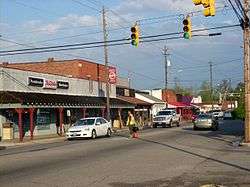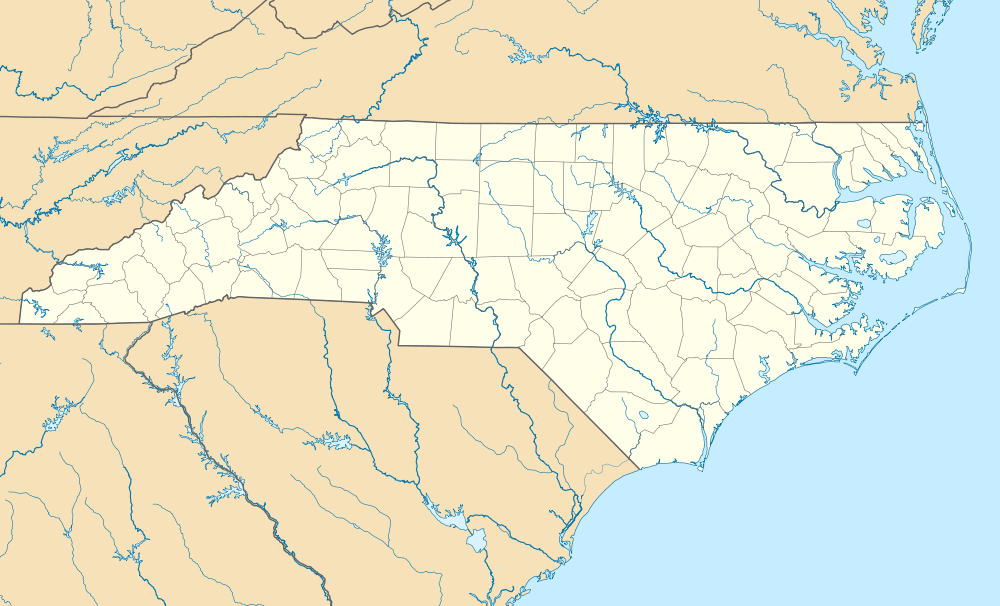Pembroke, North Carolina
Pembroke is a town in Robeson County, North Carolina, United States. It is about 90 miles inland and northwest from the Atlantic Coast. The population was 2,973, at the 2010 census. The town is the seat of the state-recognized Lumbee tribe of North Carolina, as well as the home of The University of North Carolina at Pembroke.
Pembroke, North Carolina | |
|---|---|
 Third Street in Pembroke | |
 Seal | |
| Motto(s): "Home of the Lumbee Tribe..." | |
 Pembroke, North Carolina Location within the state of North Carolina | |
| Coordinates: 34°40′55″N 79°11′45″W | |
| Country | United States |
| State | North Carolina |
| County | Robeson |
| Government | |
| • Mayor | Charles Gregory Cummings |
| Area | |
| • Total | 3.18 sq mi (8.23 km2) |
| • Land | 3.18 sq mi (8.23 km2) |
| • Water | 0.00 sq mi (0.00 km2) |
| Elevation | 171 ft (52 m) |
| Population (2010) | |
| • Total | 2,973 |
| • Estimate (2019)[2] | 2,951 |
| • Density | 928.28/sq mi (358.43/km2) |
| Time zone | UTC-5 (Eastern (EST)) |
| • Summer (DST) | UTC-4 (EDT) |
| ZIP code | 28372 |
| Area code(s) | 910 |
| FIPS code | 37-51080[3] |
| GNIS feature ID | 0992012[4] |
| Website | Town Of Pembroke North Carolina |
Geography
Pembroke is located at 34°40′55″N 79°11′45″W (34.681949, -79.195765).[5]
According to the United States Census Bureau, the town has a total area of 2.3 square miles (6.0 km2), all land.
Demographics
| Historical population | |||
|---|---|---|---|
| Census | Pop. | %± | |
| 1910 | 258 | — | |
| 1920 | 829 | 221.3% | |
| 1930 | 524 | −36.8% | |
| 1940 | 783 | 49.4% | |
| 1950 | 1,212 | 54.8% | |
| 1960 | 1,372 | 13.2% | |
| 1970 | 1,982 | 44.5% | |
| 1980 | 2,698 | 36.1% | |
| 1990 | 2,241 | −16.9% | |
| 2000 | 2,399 | 7.1% | |
| 2010 | 2,973 | 23.9% | |
| Est. 2019 | 2,951 | [2] | −0.7% |
| U.S. Decennial Census[6] | |||
| Largest ancestries (2000) [7] | Percent |
|---|---|
| Lumbee | 67% |
| African American | 5% |
| Unspecified Native American | 4% |
| Irish | 2% |
| English | 2% |
| Scottish | 2% |
| French | 1% |
According to the 2000 census,[3] there were 2,399 people, 961 households, and 611 families residing in the town. The population density was 1,023.9 people per square mile (395.8/km2). There were 1,043 housing units at an average density of 445.1 per square mile (172.1/km2). The racial makeup of the town was:
- 88.90% Native American
- 8.15% White
- 2.20% African American
- 0.54% Asian
- 0.00% Pacific Islander
- 0.53% from other races
- 0.70% from two or more races.
- Hispanic or Latino of any race were 1.08% of the population.
There were 961 households, out of which 35.7% had children under the age of 18 living with them, 27.3% were married couples living together, 32.5% had a female householder with no husband present, and 36.4% were non-families. 32.5% of all households were made up of individuals, and 11.2% had someone living alone who was 65 years of age or older. The average household size was 2.46 and the average family size was 3.12.
In the town, the population was spread out, with 34.8% under the age of 18, 11.5% from 18 to 24, 25.8% from 25 to 44, 17.6% from 45 to 64, and 10.3% who were 65 years of age or older. The median age was 27 years. For every 100 females, there were 75.2 males. For every 100 females age 18 and over, there were 64.9 males.
The median income for a household in the town was $18,355, and the median income for a family was $21,218. Males had a median income of $26,875 versus $21,510 for females. The per capita income for the town was $10,202. About 39.9% of families and 40.7% of the population were below the poverty line, including 54.3% of those under age 18 and 34.1% of those age 65 or over.
According to the 2010 US Census, the population was 2,937. Of this, 1,975 (66.43%) were American Indian or Alaska Native, 489 (16.45%) were White, 367 (12.34%) were Black or African American, 101 (3.40%) were two or more races, 18 (0.61%) were some other race, 17 (0.57%) were Asian, 6 (0.20%) were Native Hawaiian or other Pacific Islander. 65 (2.19%) were Hispanic or Latino of any race.[8]
History
Pembroke was previously known as Raleigh. Archaeological excavations now being performed throughout Robeson County reveal a long and rich history of widespread occupation, especially near the Lumber River (formerly known by colonists as Drowning Creek), since the end of the last Ice Age. Indigenous settlements were located along the Lumber River. Artifacts found there have been dated to the early Woodland period. The artifacts include a variety of goods that suggest that Native American settlements along the river were part of an extensive trade network with other regions of what is now the Southeast of the United States.
After colonial contact, European-made items, such as kaolin tobacco pipes, were traded by the Spanish, French, and the English to Native American peoples of the coast. Such items have been revealed among archeological artifacts, attesting to the trade.
Swamps, streams, and artesian wells provided a supply of water for Native peoples. Fish was plentiful, and the region's lush vegetation included numerous food crops. "Carolina bays", creeks, swamps, pocosins, and longleaf pines continue to mark the distinctive wetland landscape of Pembroke.
In 1725, colonial English surveyors for the Wineau factory mapped a village of Waccamaw on what is now known as the Lumber River, a few miles west of present-day Pembroke. In 1754, North Carolina Governor Arthur Dobbs received a report from his agent, Col. Rutherford, the head of a Bladen County militia, that 50 families were living along Drowning Creek (now known as the Lumber River); they were northern Irish and highland Scots immigrants. The communication also reported the shooting of a surveyor who entered the area "to view vacant lands." They reported no Indians in Robeson County area.
In the later 18th century, a variety of European-American colonists settled in the area as did Lumbee ancestors. Some of the latter are believed to have migrated from the area of the Roanoke River in Halifax and Edgecombe counties in North Carolina. Other Lumbee ancestral names have been traced to free people of color established as free in Virginia, particularly Louisa County, before the American Revolutionary War. After the war, they and neighbors migrated to other territories.[9]
The Lowry War of 1861 to 1874, considered significant in Lumbee history, took place in and around Pembroke. The insurgency was led by Henry Berry Lowry, a 17-year-old Lumbee whose father and brother were murdered by the Confederate Home Guard. This outlaw band of Native Americans, African Americans and whites waged a seven-year guerrilla war against the Homeguard and county elite in the areas near Robeson and Pembroke. During the fighting, Lowry and many others escaped into the surrounding swamps, a tactic that they used repeatedly, helping them evade capture.
As the American Civil War dragged on, food became scarce in the area, as more outliers (including escaped slaves, Confederate deserters and Union prison escapees) fled to this sanctuary. The outlaws decided to live off the wealthy class of people instead of the poor. The band raided plantations and distributed food to the poor in Pembroke, which was known then as "Scuffletown" or "The Settlement". Toward century's end, the town was renamed for railroad official Pembroke Jones.
In the late 19th century, families who had been free people of color before the Civil War petitioned the state to have their own Indian schools. State representative Hamilton McMillan supported this and suggested they should be called the Croatan Indians. The state authorized them to have schools separate from those serving freedmen's children. Under the racially segregated system, they were excluded from schools for whites.
The Old Main, The University of North Carolina at Pembroke and Pembroke High School, Former are listed on the National Register of Historic Places.[10]
Today
Pembroke is the tribal seat of the Lumbee Tribe of North Carolina, the largest state-recognized tribe east of the Mississippi River. It is the largest state-recognized tribe that does not have a reservation. The origin of the Lumbee has been disputed historically, as the people are multi-tribal. Some tribes migrating from neighboring counties and states. In the 1950s, those who identified as Native American chose the name Lumbee, after what is now known as the Lumber River.
Pembroke is home of Indian Normal School, a master's level degree-granting university and one of the 17 schools that comprise the University of North Carolina system. It was incorporated within the University of North Carolina system in 1972 and officially became the University of North Carolina at Pembroke in 1996. The total enrollment within the university is 6,944 as of 2010. With a 16:1 student to faculty ratio, the average class size is 21. Pembroke is the safest campus among the UNC schools according to the U.S. News and World Report and is among the nation's most diverse. According to their motto, it's "Where learning gets personal."
Notable people
- Nate Andrews, former MLB pitcher and 1944 All-Star selection
- Chris Chavis, professional wrestler better known as "Tatanka" in the WWE
- Henry Berry Lowrie, leader of the Lowry gang during the Civil War
- Lee McRae, NCAA national champion sprinter and 1987 World champion in the 4x100 meter relay[11]
- Mike McRae, long jumper who represented the United States at the 1984 Summer Olympics[12]
- Ruth Revels, American Indian Activist and educator[13]
- Kelvin Sampson, college basketball head coach
See also
- The Lowry War
References
- "2019 U.S. Gazetteer Files". United States Census Bureau. Retrieved July 27, 2020.
- "Population and Housing Unit Estimates". United States Census Bureau. May 24, 2020. Retrieved May 27, 2020.
- "U.S. Census website". United States Census Bureau. Retrieved January 31, 2008.
- "US Board on Geographic Names". United States Geological Survey. October 25, 2007. Retrieved January 31, 2008.
- "US Gazetteer files: 2010, 2000, and 1990". United States Census Bureau. February 12, 2011. Retrieved April 23, 2011.
- "Census of Population and Housing". Census.gov. Retrieved June 4, 2015.
- http://www.epodunk.com/cgi-bin/genealogyInfo.php?locIndex=19552
- http://censusviewer.com/city/NC/pembroke/2010
- Paul Heinegg, Free African American Families of Virginia, North Carolina, South Carolina, Maryland and Delaware, 1995-2003
- "National Register Information System". National Register of Historic Places. National Park Service. July 9, 2010.
- Hersch, Hank. May 18, 1987. Number One At The Gun. Vault. Retrieved 26 May 2019.
- Mike McRae Bio. Sports-Reference/Olympic Sports. Retrieved 26 May 2019.
- March 15, 2016. Lumbee advocate, Revels, dies. The Robesonian. Retrieved 26 May 2019.
- William McKee Evans, "To Die Game:" The Story of the Lowry Band, Indian Guerrillas of Reconstruction, Syracuse University Press, 1995
- Adolph L. Dial, David K. Eliades, "The Only Land I Know: A History of the Lumbee Indians", Syracuse University Press, 1996
- Karen I. Blu, The Lumbee Problem: The Making of an American Indian, University of Nebraska Press, 2001
- E. Stanly Godbold, Jr. and Mattie U. Russell, Confederate Colonel And Cherokee Chief: The Life Of William Holland Thomas, University of Tennessee Press, 1990